Analysis of Management, People and Teams Issues - MGT600 Report
VerifiedAdded on 2023/06/09
|11
|2712
|415
Report
AI Summary
This report examines the challenges faced by ComSyst Technologies, a system developer, focusing on issues related to management, people, and teams. The company is experiencing declining market share, low employee engagement, staff retention problems, poor individual performance, and resignations of key authorities. The report explores the importance of attracting and retaining talent, emphasizing the need for a supportive work environment that fosters employee motivation and development. It discusses key aspects of human resource management, including performance management, team development, and change management. Recommendations are provided to address these issues, such as improving employee attraction and retention, enhancing teamwork, optimizing performance management, and implementing effective change management strategies. The report also highlights the importance of strategic people management, effective communication, and the impact of these factors on organizational performance. It emphasizes the need for clear expectations, strong relationships, and open communication to foster innovation and problem-solving within the organization. Ultimately, the report aims to provide insights and solutions to help ComSyst Technologies improve its people management practices and achieve its strategic goals.
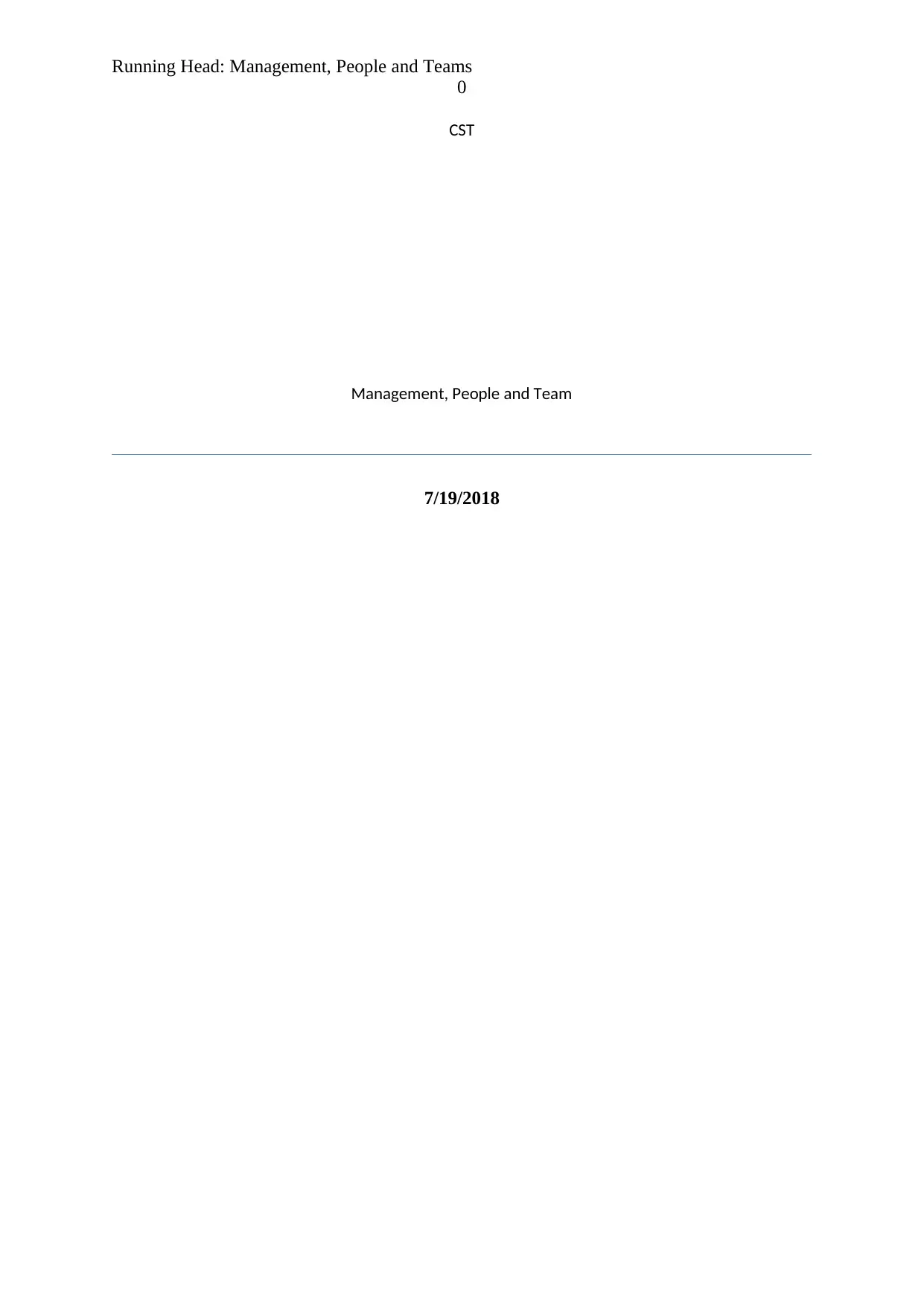
Running Head: Management, People and Teams
0
CST
Management, People and Team
7/19/2018
0
CST
Management, People and Team
7/19/2018
Paraphrase This Document
Need a fresh take? Get an instant paraphrase of this document with our AI Paraphraser
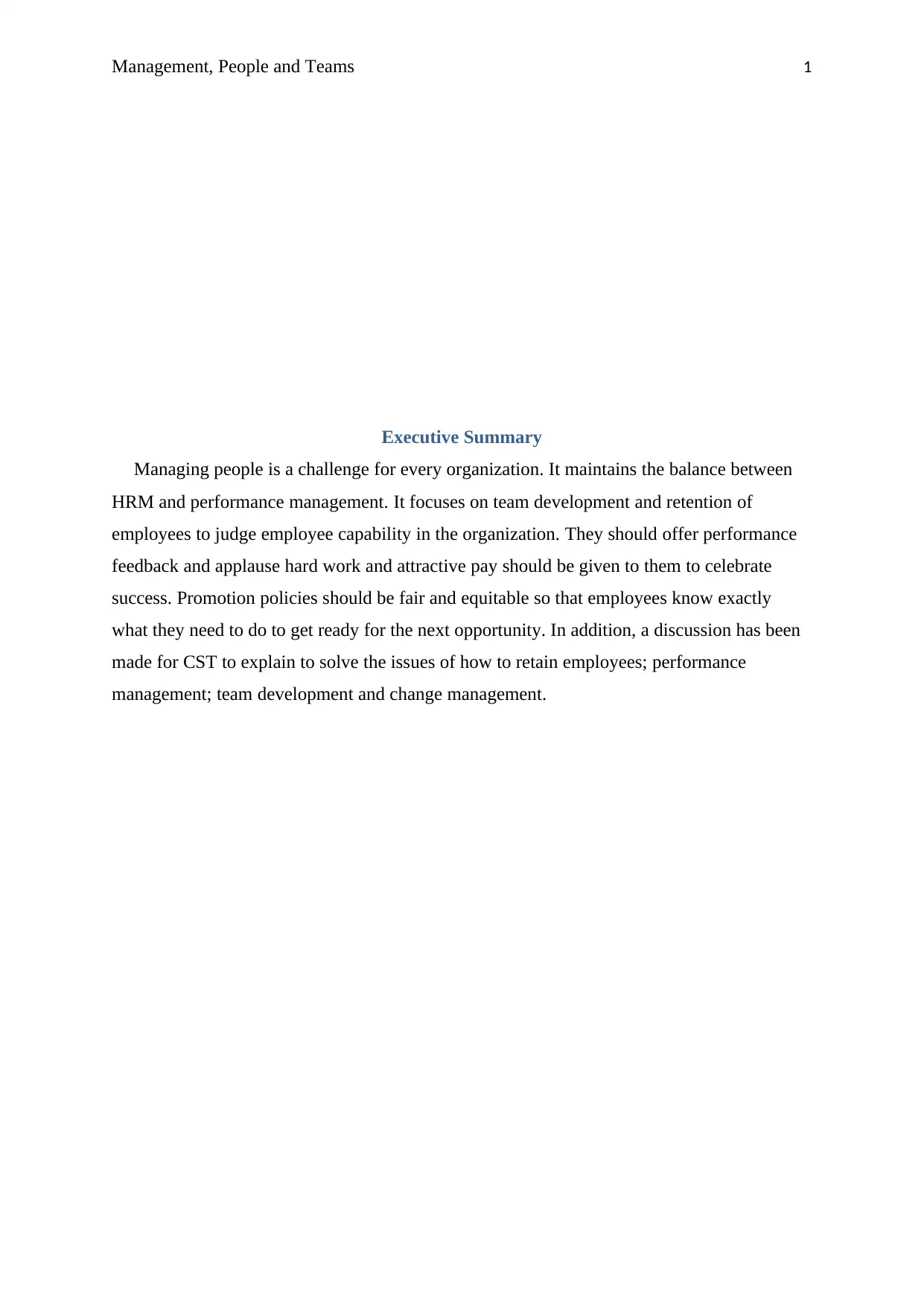
Management, People and Teams 1
Executive Summary
Managing people is a challenge for every organization. It maintains the balance between
HRM and performance management. It focuses on team development and retention of
employees to judge employee capability in the organization. They should offer performance
feedback and applause hard work and attractive pay should be given to them to celebrate
success. Promotion policies should be fair and equitable so that employees know exactly
what they need to do to get ready for the next opportunity. In addition, a discussion has been
made for CST to explain to solve the issues of how to retain employees; performance
management; team development and change management.
Executive Summary
Managing people is a challenge for every organization. It maintains the balance between
HRM and performance management. It focuses on team development and retention of
employees to judge employee capability in the organization. They should offer performance
feedback and applause hard work and attractive pay should be given to them to celebrate
success. Promotion policies should be fair and equitable so that employees know exactly
what they need to do to get ready for the next opportunity. In addition, a discussion has been
made for CST to explain to solve the issues of how to retain employees; performance
management; team development and change management.
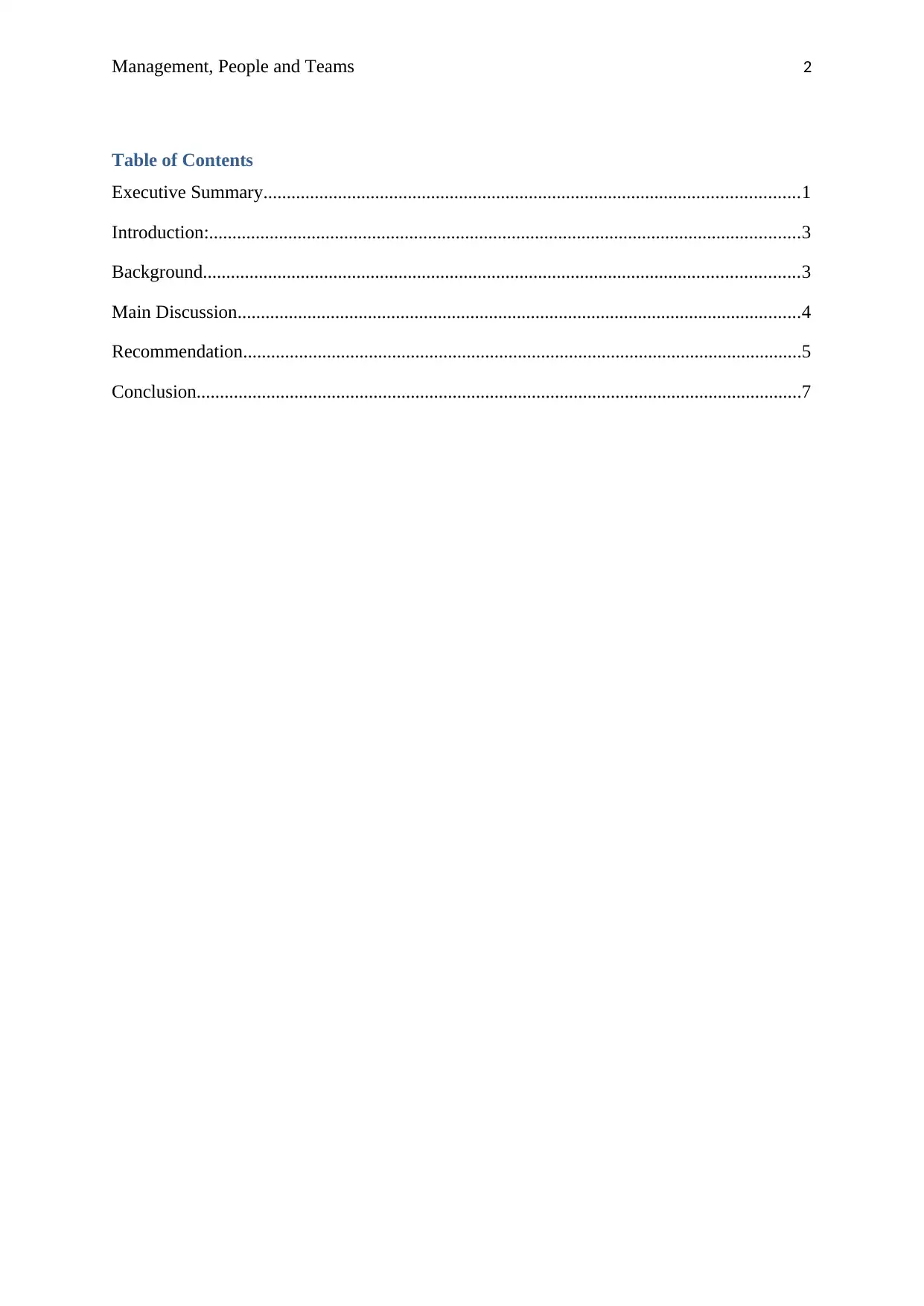
Management, People and Teams 2
Table of Contents
Executive Summary...................................................................................................................1
Introduction:...............................................................................................................................3
Background................................................................................................................................3
Main Discussion.........................................................................................................................4
Recommendation........................................................................................................................5
Conclusion..................................................................................................................................7
Table of Contents
Executive Summary...................................................................................................................1
Introduction:...............................................................................................................................3
Background................................................................................................................................3
Main Discussion.........................................................................................................................4
Recommendation........................................................................................................................5
Conclusion..................................................................................................................................7
⊘ This is a preview!⊘
Do you want full access?
Subscribe today to unlock all pages.

Trusted by 1+ million students worldwide
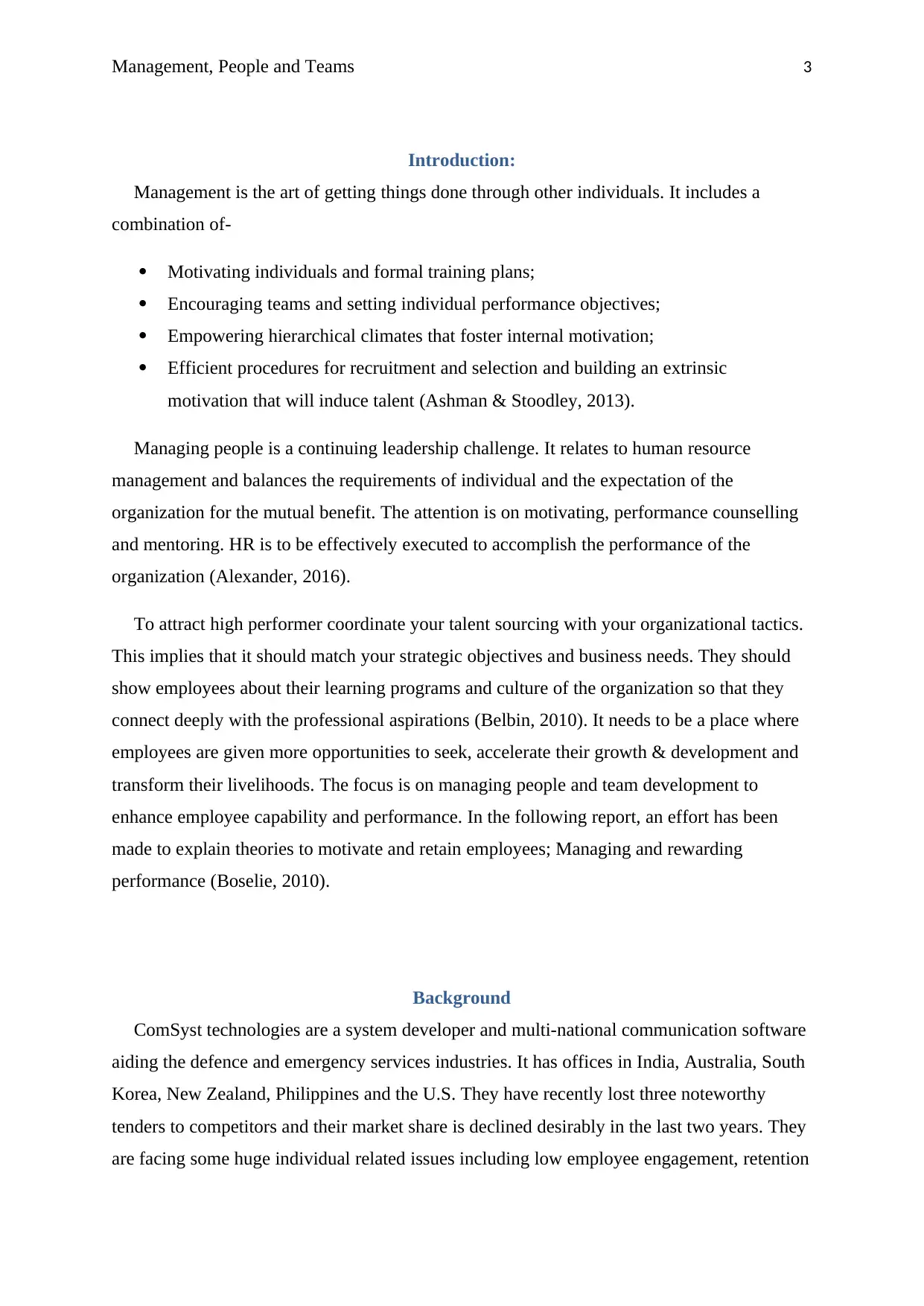
Management, People and Teams 3
Introduction:
Management is the art of getting things done through other individuals. It includes a
combination of-
Motivating individuals and formal training plans;
Encouraging teams and setting individual performance objectives;
Empowering hierarchical climates that foster internal motivation;
Efficient procedures for recruitment and selection and building an extrinsic
motivation that will induce talent (Ashman & Stoodley, 2013).
Managing people is a continuing leadership challenge. It relates to human resource
management and balances the requirements of individual and the expectation of the
organization for the mutual benefit. The attention is on motivating, performance counselling
and mentoring. HR is to be effectively executed to accomplish the performance of the
organization (Alexander, 2016).
To attract high performer coordinate your talent sourcing with your organizational tactics.
This implies that it should match your strategic objectives and business needs. They should
show employees about their learning programs and culture of the organization so that they
connect deeply with the professional aspirations (Belbin, 2010). It needs to be a place where
employees are given more opportunities to seek, accelerate their growth & development and
transform their livelihoods. The focus is on managing people and team development to
enhance employee capability and performance. In the following report, an effort has been
made to explain theories to motivate and retain employees; Managing and rewarding
performance (Boselie, 2010).
Background
ComSyst technologies are a system developer and multi-national communication software
aiding the defence and emergency services industries. It has offices in India, Australia, South
Korea, New Zealand, Philippines and the U.S. They have recently lost three noteworthy
tenders to competitors and their market share is declined desirably in the last two years. They
are facing some huge individual related issues including low employee engagement, retention
Introduction:
Management is the art of getting things done through other individuals. It includes a
combination of-
Motivating individuals and formal training plans;
Encouraging teams and setting individual performance objectives;
Empowering hierarchical climates that foster internal motivation;
Efficient procedures for recruitment and selection and building an extrinsic
motivation that will induce talent (Ashman & Stoodley, 2013).
Managing people is a continuing leadership challenge. It relates to human resource
management and balances the requirements of individual and the expectation of the
organization for the mutual benefit. The attention is on motivating, performance counselling
and mentoring. HR is to be effectively executed to accomplish the performance of the
organization (Alexander, 2016).
To attract high performer coordinate your talent sourcing with your organizational tactics.
This implies that it should match your strategic objectives and business needs. They should
show employees about their learning programs and culture of the organization so that they
connect deeply with the professional aspirations (Belbin, 2010). It needs to be a place where
employees are given more opportunities to seek, accelerate their growth & development and
transform their livelihoods. The focus is on managing people and team development to
enhance employee capability and performance. In the following report, an effort has been
made to explain theories to motivate and retain employees; Managing and rewarding
performance (Boselie, 2010).
Background
ComSyst technologies are a system developer and multi-national communication software
aiding the defence and emergency services industries. It has offices in India, Australia, South
Korea, New Zealand, Philippines and the U.S. They have recently lost three noteworthy
tenders to competitors and their market share is declined desirably in the last two years. They
are facing some huge individual related issues including low employee engagement, retention
Paraphrase This Document
Need a fresh take? Get an instant paraphrase of this document with our AI Paraphraser
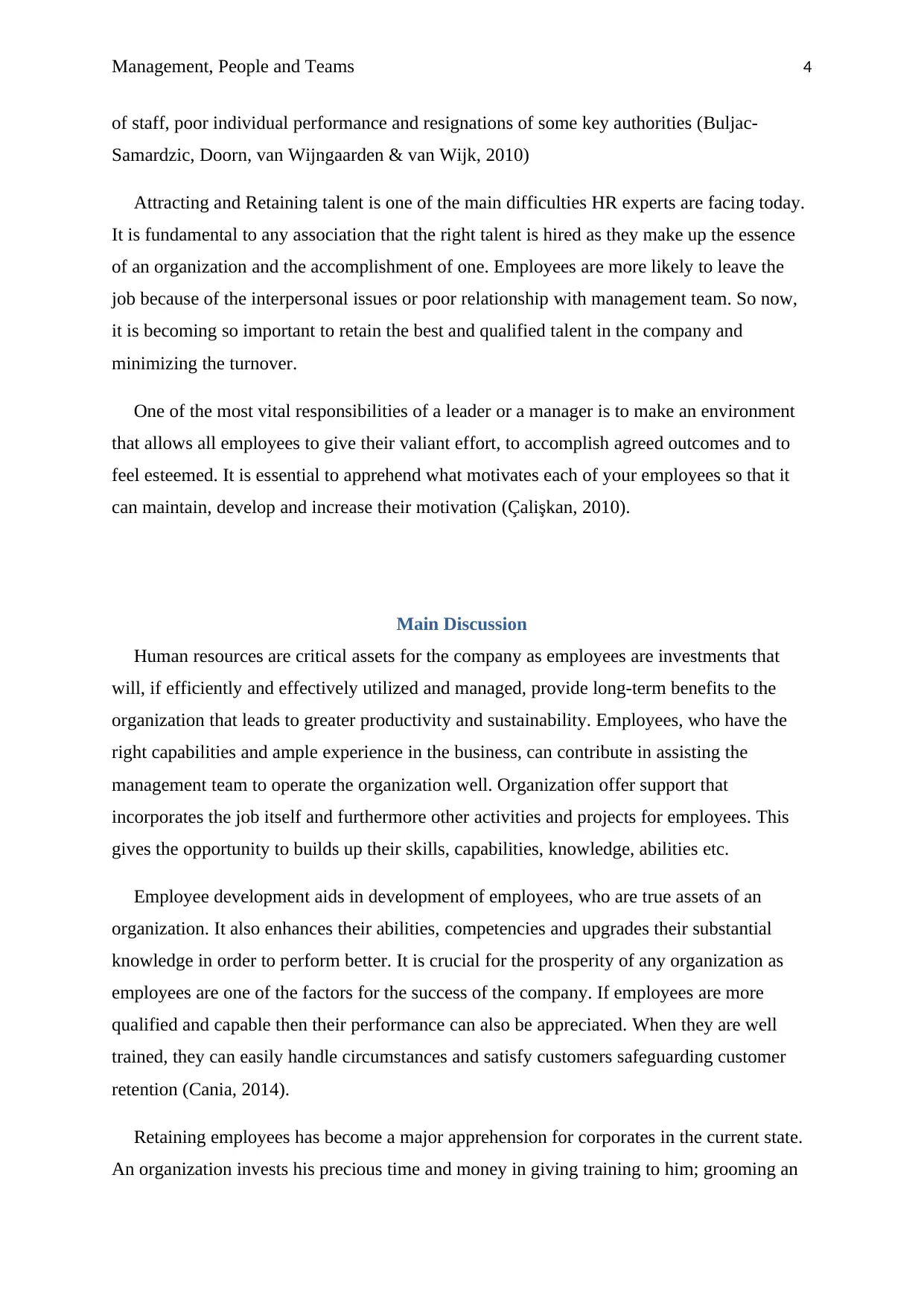
Management, People and Teams 4
of staff, poor individual performance and resignations of some key authorities (Buljac-
Samardzic, Doorn, van Wijngaarden & van Wijk, 2010)
Attracting and Retaining talent is one of the main difficulties HR experts are facing today.
It is fundamental to any association that the right talent is hired as they make up the essence
of an organization and the accomplishment of one. Employees are more likely to leave the
job because of the interpersonal issues or poor relationship with management team. So now,
it is becoming so important to retain the best and qualified talent in the company and
minimizing the turnover.
One of the most vital responsibilities of a leader or a manager is to make an environment
that allows all employees to give their valiant effort, to accomplish agreed outcomes and to
feel esteemed. It is essential to apprehend what motivates each of your employees so that it
can maintain, develop and increase their motivation (Çalişkan, 2010).
Main Discussion
Human resources are critical assets for the company as employees are investments that
will, if efficiently and effectively utilized and managed, provide long-term benefits to the
organization that leads to greater productivity and sustainability. Employees, who have the
right capabilities and ample experience in the business, can contribute in assisting the
management team to operate the organization well. Organization offer support that
incorporates the job itself and furthermore other activities and projects for employees. This
gives the opportunity to builds up their skills, capabilities, knowledge, abilities etc.
Employee development aids in development of employees, who are true assets of an
organization. It also enhances their abilities, competencies and upgrades their substantial
knowledge in order to perform better. It is crucial for the prosperity of any organization as
employees are one of the factors for the success of the company. If employees are more
qualified and capable then their performance can also be appreciated. When they are well
trained, they can easily handle circumstances and satisfy customers safeguarding customer
retention (Cania, 2014).
Retaining employees has become a major apprehension for corporates in the current state.
An organization invests his precious time and money in giving training to him; grooming an
of staff, poor individual performance and resignations of some key authorities (Buljac-
Samardzic, Doorn, van Wijngaarden & van Wijk, 2010)
Attracting and Retaining talent is one of the main difficulties HR experts are facing today.
It is fundamental to any association that the right talent is hired as they make up the essence
of an organization and the accomplishment of one. Employees are more likely to leave the
job because of the interpersonal issues or poor relationship with management team. So now,
it is becoming so important to retain the best and qualified talent in the company and
minimizing the turnover.
One of the most vital responsibilities of a leader or a manager is to make an environment
that allows all employees to give their valiant effort, to accomplish agreed outcomes and to
feel esteemed. It is essential to apprehend what motivates each of your employees so that it
can maintain, develop and increase their motivation (Çalişkan, 2010).
Main Discussion
Human resources are critical assets for the company as employees are investments that
will, if efficiently and effectively utilized and managed, provide long-term benefits to the
organization that leads to greater productivity and sustainability. Employees, who have the
right capabilities and ample experience in the business, can contribute in assisting the
management team to operate the organization well. Organization offer support that
incorporates the job itself and furthermore other activities and projects for employees. This
gives the opportunity to builds up their skills, capabilities, knowledge, abilities etc.
Employee development aids in development of employees, who are true assets of an
organization. It also enhances their abilities, competencies and upgrades their substantial
knowledge in order to perform better. It is crucial for the prosperity of any organization as
employees are one of the factors for the success of the company. If employees are more
qualified and capable then their performance can also be appreciated. When they are well
trained, they can easily handle circumstances and satisfy customers safeguarding customer
retention (Cania, 2014).
Retaining employees has become a major apprehension for corporates in the current state.
An organization invests his precious time and money in giving training to him; grooming an
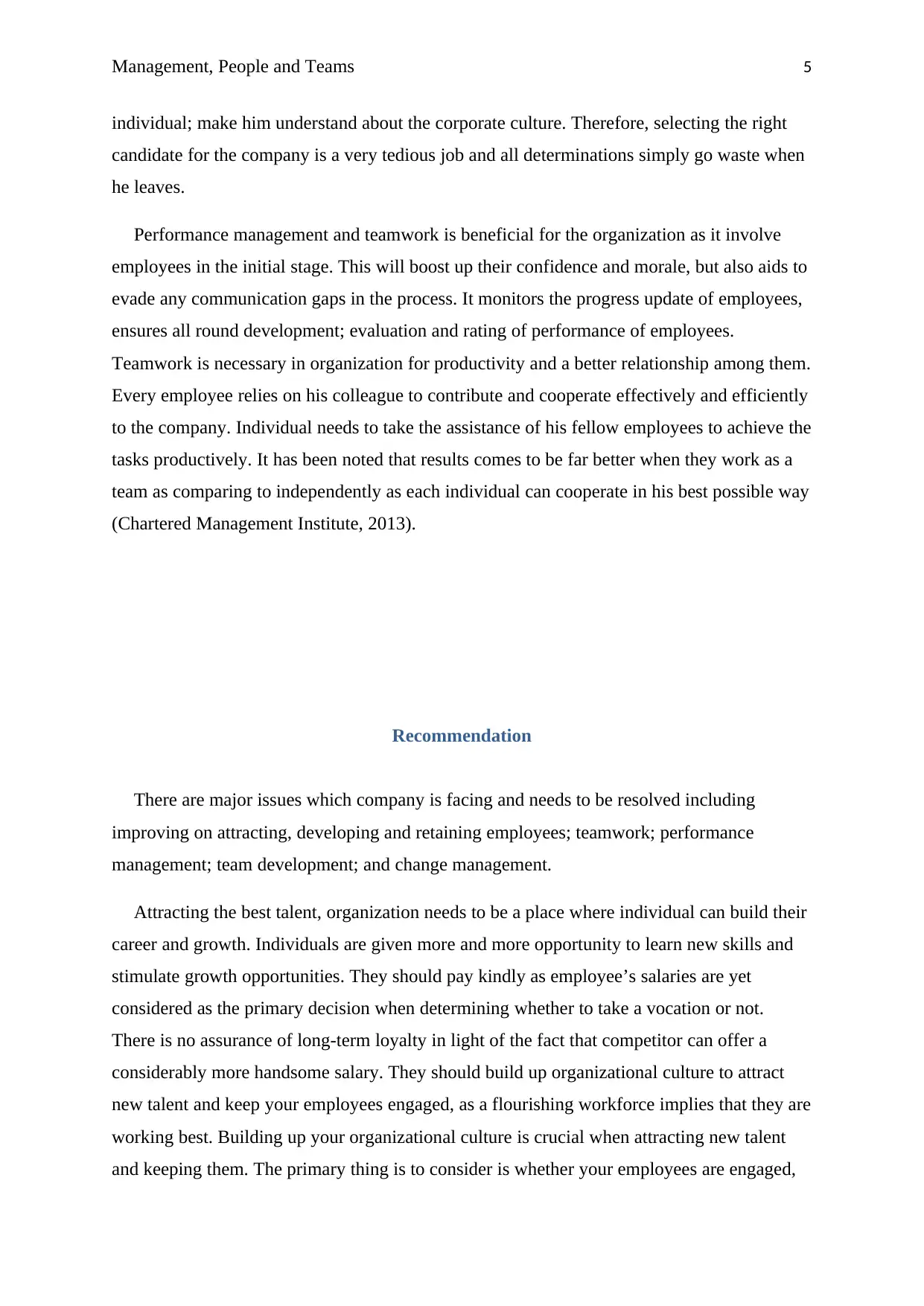
Management, People and Teams 5
individual; make him understand about the corporate culture. Therefore, selecting the right
candidate for the company is a very tedious job and all determinations simply go waste when
he leaves.
Performance management and teamwork is beneficial for the organization as it involve
employees in the initial stage. This will boost up their confidence and morale, but also aids to
evade any communication gaps in the process. It monitors the progress update of employees,
ensures all round development; evaluation and rating of performance of employees.
Teamwork is necessary in organization for productivity and a better relationship among them.
Every employee relies on his colleague to contribute and cooperate effectively and efficiently
to the company. Individual needs to take the assistance of his fellow employees to achieve the
tasks productively. It has been noted that results comes to be far better when they work as a
team as comparing to independently as each individual can cooperate in his best possible way
(Chartered Management Institute, 2013).
Recommendation
There are major issues which company is facing and needs to be resolved including
improving on attracting, developing and retaining employees; teamwork; performance
management; team development; and change management.
Attracting the best talent, organization needs to be a place where individual can build their
career and growth. Individuals are given more and more opportunity to learn new skills and
stimulate growth opportunities. They should pay kindly as employee’s salaries are yet
considered as the primary decision when determining whether to take a vocation or not.
There is no assurance of long-term loyalty in light of the fact that competitor can offer a
considerably more handsome salary. They should build up organizational culture to attract
new talent and keep your employees engaged, as a flourishing workforce implies that they are
working best. Building up your organizational culture is crucial when attracting new talent
and keeping them. The primary thing is to consider is whether your employees are engaged,
individual; make him understand about the corporate culture. Therefore, selecting the right
candidate for the company is a very tedious job and all determinations simply go waste when
he leaves.
Performance management and teamwork is beneficial for the organization as it involve
employees in the initial stage. This will boost up their confidence and morale, but also aids to
evade any communication gaps in the process. It monitors the progress update of employees,
ensures all round development; evaluation and rating of performance of employees.
Teamwork is necessary in organization for productivity and a better relationship among them.
Every employee relies on his colleague to contribute and cooperate effectively and efficiently
to the company. Individual needs to take the assistance of his fellow employees to achieve the
tasks productively. It has been noted that results comes to be far better when they work as a
team as comparing to independently as each individual can cooperate in his best possible way
(Chartered Management Institute, 2013).
Recommendation
There are major issues which company is facing and needs to be resolved including
improving on attracting, developing and retaining employees; teamwork; performance
management; team development; and change management.
Attracting the best talent, organization needs to be a place where individual can build their
career and growth. Individuals are given more and more opportunity to learn new skills and
stimulate growth opportunities. They should pay kindly as employee’s salaries are yet
considered as the primary decision when determining whether to take a vocation or not.
There is no assurance of long-term loyalty in light of the fact that competitor can offer a
considerably more handsome salary. They should build up organizational culture to attract
new talent and keep your employees engaged, as a flourishing workforce implies that they are
working best. Building up your organizational culture is crucial when attracting new talent
and keeping them. The primary thing is to consider is whether your employees are engaged,
⊘ This is a preview!⊘
Do you want full access?
Subscribe today to unlock all pages.

Trusted by 1+ million students worldwide
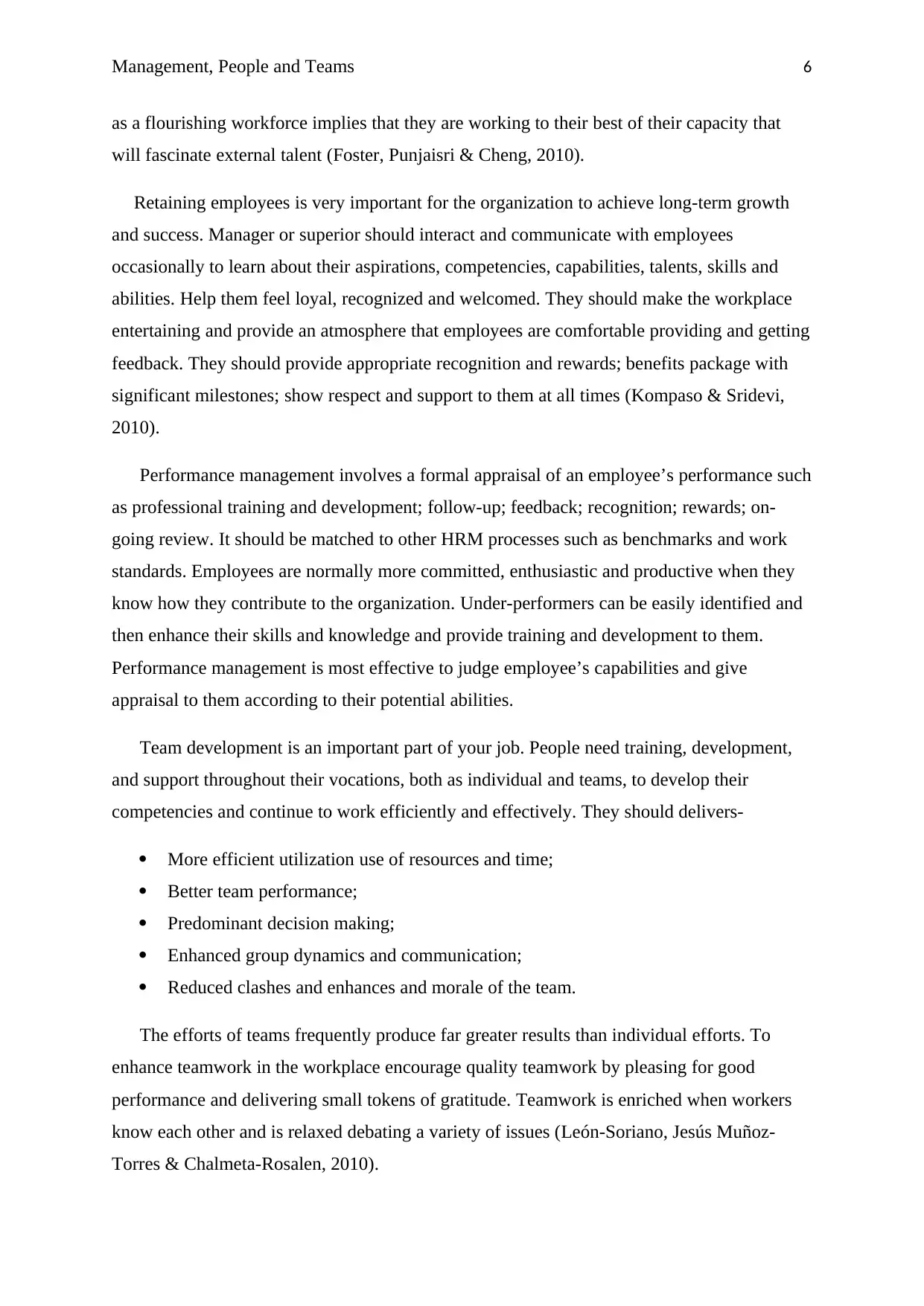
Management, People and Teams 6
as a flourishing workforce implies that they are working to their best of their capacity that
will fascinate external talent (Foster, Punjaisri & Cheng, 2010).
Retaining employees is very important for the organization to achieve long-term growth
and success. Manager or superior should interact and communicate with employees
occasionally to learn about their aspirations, competencies, capabilities, talents, skills and
abilities. Help them feel loyal, recognized and welcomed. They should make the workplace
entertaining and provide an atmosphere that employees are comfortable providing and getting
feedback. They should provide appropriate recognition and rewards; benefits package with
significant milestones; show respect and support to them at all times (Kompaso & Sridevi,
2010).
Performance management involves a formal appraisal of an employee’s performance such
as professional training and development; follow-up; feedback; recognition; rewards; on-
going review. It should be matched to other HRM processes such as benchmarks and work
standards. Employees are normally more committed, enthusiastic and productive when they
know how they contribute to the organization. Under-performers can be easily identified and
then enhance their skills and knowledge and provide training and development to them.
Performance management is most effective to judge employee’s capabilities and give
appraisal to them according to their potential abilities.
Team development is an important part of your job. People need training, development,
and support throughout their vocations, both as individual and teams, to develop their
competencies and continue to work efficiently and effectively. They should delivers-
More efficient utilization use of resources and time;
Better team performance;
Predominant decision making;
Enhanced group dynamics and communication;
Reduced clashes and enhances and morale of the team.
The efforts of teams frequently produce far greater results than individual efforts. To
enhance teamwork in the workplace encourage quality teamwork by pleasing for good
performance and delivering small tokens of gratitude. Teamwork is enriched when workers
know each other and is relaxed debating a variety of issues (León-Soriano, Jesús Muñoz-
Torres & Chalmeta-Rosalen, 2010).
as a flourishing workforce implies that they are working to their best of their capacity that
will fascinate external talent (Foster, Punjaisri & Cheng, 2010).
Retaining employees is very important for the organization to achieve long-term growth
and success. Manager or superior should interact and communicate with employees
occasionally to learn about their aspirations, competencies, capabilities, talents, skills and
abilities. Help them feel loyal, recognized and welcomed. They should make the workplace
entertaining and provide an atmosphere that employees are comfortable providing and getting
feedback. They should provide appropriate recognition and rewards; benefits package with
significant milestones; show respect and support to them at all times (Kompaso & Sridevi,
2010).
Performance management involves a formal appraisal of an employee’s performance such
as professional training and development; follow-up; feedback; recognition; rewards; on-
going review. It should be matched to other HRM processes such as benchmarks and work
standards. Employees are normally more committed, enthusiastic and productive when they
know how they contribute to the organization. Under-performers can be easily identified and
then enhance their skills and knowledge and provide training and development to them.
Performance management is most effective to judge employee’s capabilities and give
appraisal to them according to their potential abilities.
Team development is an important part of your job. People need training, development,
and support throughout their vocations, both as individual and teams, to develop their
competencies and continue to work efficiently and effectively. They should delivers-
More efficient utilization use of resources and time;
Better team performance;
Predominant decision making;
Enhanced group dynamics and communication;
Reduced clashes and enhances and morale of the team.
The efforts of teams frequently produce far greater results than individual efforts. To
enhance teamwork in the workplace encourage quality teamwork by pleasing for good
performance and delivering small tokens of gratitude. Teamwork is enriched when workers
know each other and is relaxed debating a variety of issues (León-Soriano, Jesús Muñoz-
Torres & Chalmeta-Rosalen, 2010).
Paraphrase This Document
Need a fresh take? Get an instant paraphrase of this document with our AI Paraphraser
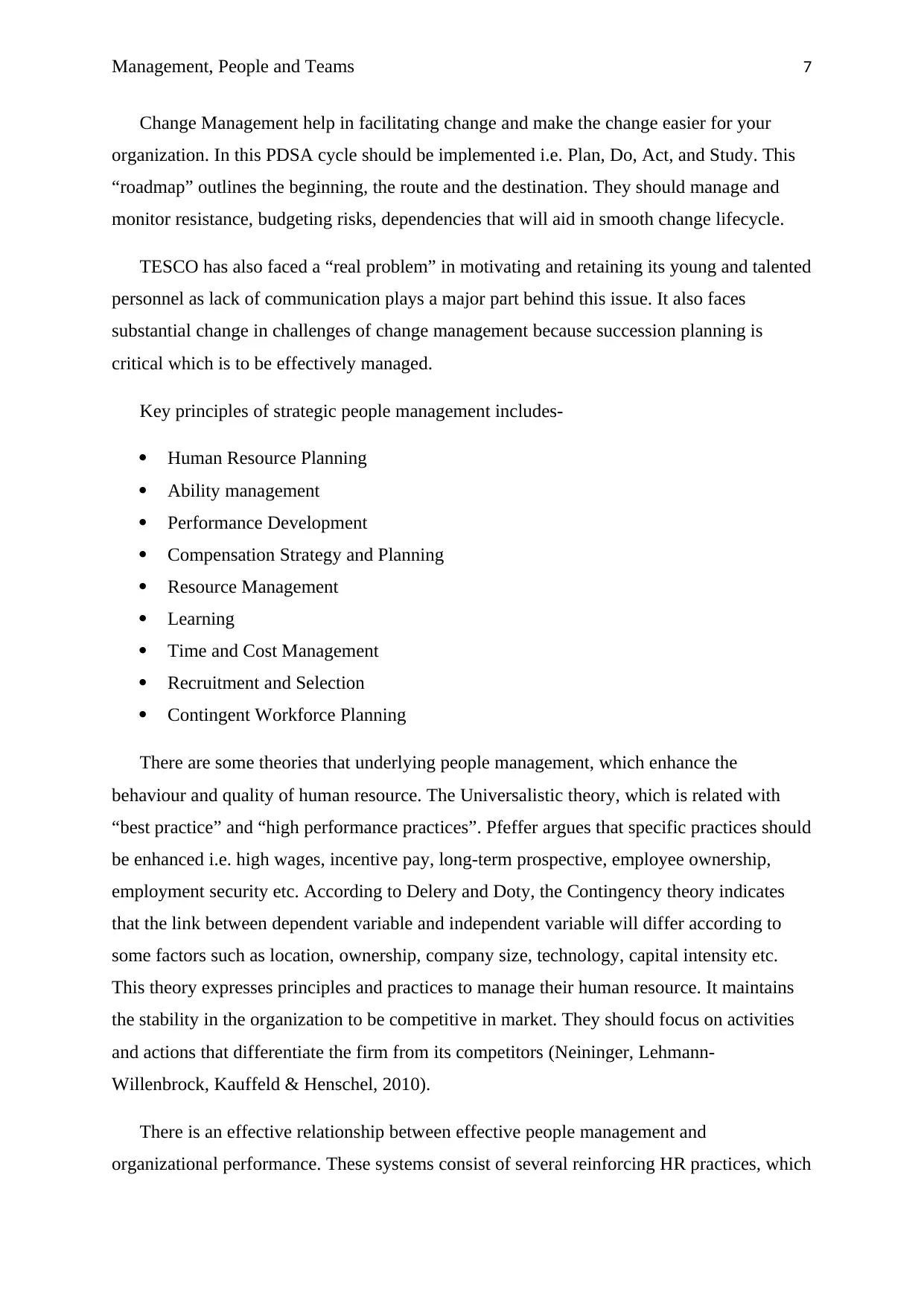
Management, People and Teams 7
Change Management help in facilitating change and make the change easier for your
organization. In this PDSA cycle should be implemented i.e. Plan, Do, Act, and Study. This
“roadmap” outlines the beginning, the route and the destination. They should manage and
monitor resistance, budgeting risks, dependencies that will aid in smooth change lifecycle.
TESCO has also faced a “real problem” in motivating and retaining its young and talented
personnel as lack of communication plays a major part behind this issue. It also faces
substantial change in challenges of change management because succession planning is
critical which is to be effectively managed.
Key principles of strategic people management includes-
Human Resource Planning
Ability management
Performance Development
Compensation Strategy and Planning
Resource Management
Learning
Time and Cost Management
Recruitment and Selection
Contingent Workforce Planning
There are some theories that underlying people management, which enhance the
behaviour and quality of human resource. The Universalistic theory, which is related with
“best practice” and “high performance practices”. Pfeffer argues that specific practices should
be enhanced i.e. high wages, incentive pay, long-term prospective, employee ownership,
employment security etc. According to Delery and Doty, the Contingency theory indicates
that the link between dependent variable and independent variable will differ according to
some factors such as location, ownership, company size, technology, capital intensity etc.
This theory expresses principles and practices to manage their human resource. It maintains
the stability in the organization to be competitive in market. They should focus on activities
and actions that differentiate the firm from its competitors (Neininger, Lehmann-
Willenbrock, Kauffeld & Henschel, 2010).
There is an effective relationship between effective people management and
organizational performance. These systems consist of several reinforcing HR practices, which
Change Management help in facilitating change and make the change easier for your
organization. In this PDSA cycle should be implemented i.e. Plan, Do, Act, and Study. This
“roadmap” outlines the beginning, the route and the destination. They should manage and
monitor resistance, budgeting risks, dependencies that will aid in smooth change lifecycle.
TESCO has also faced a “real problem” in motivating and retaining its young and talented
personnel as lack of communication plays a major part behind this issue. It also faces
substantial change in challenges of change management because succession planning is
critical which is to be effectively managed.
Key principles of strategic people management includes-
Human Resource Planning
Ability management
Performance Development
Compensation Strategy and Planning
Resource Management
Learning
Time and Cost Management
Recruitment and Selection
Contingent Workforce Planning
There are some theories that underlying people management, which enhance the
behaviour and quality of human resource. The Universalistic theory, which is related with
“best practice” and “high performance practices”. Pfeffer argues that specific practices should
be enhanced i.e. high wages, incentive pay, long-term prospective, employee ownership,
employment security etc. According to Delery and Doty, the Contingency theory indicates
that the link between dependent variable and independent variable will differ according to
some factors such as location, ownership, company size, technology, capital intensity etc.
This theory expresses principles and practices to manage their human resource. It maintains
the stability in the organization to be competitive in market. They should focus on activities
and actions that differentiate the firm from its competitors (Neininger, Lehmann-
Willenbrock, Kauffeld & Henschel, 2010).
There is an effective relationship between effective people management and
organizational performance. These systems consist of several reinforcing HR practices, which
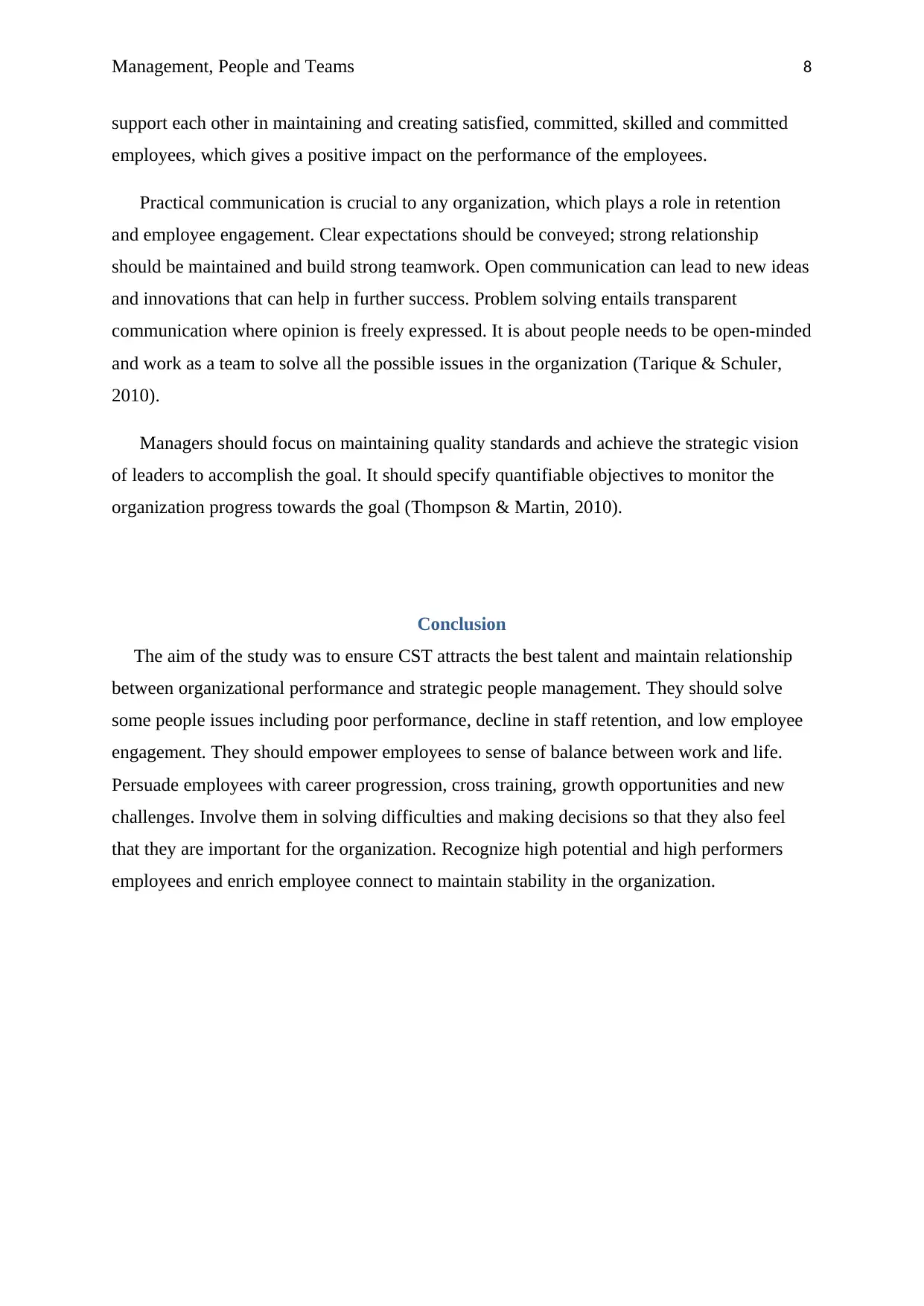
Management, People and Teams 8
support each other in maintaining and creating satisfied, committed, skilled and committed
employees, which gives a positive impact on the performance of the employees.
Practical communication is crucial to any organization, which plays a role in retention
and employee engagement. Clear expectations should be conveyed; strong relationship
should be maintained and build strong teamwork. Open communication can lead to new ideas
and innovations that can help in further success. Problem solving entails transparent
communication where opinion is freely expressed. It is about people needs to be open-minded
and work as a team to solve all the possible issues in the organization (Tarique & Schuler,
2010).
Managers should focus on maintaining quality standards and achieve the strategic vision
of leaders to accomplish the goal. It should specify quantifiable objectives to monitor the
organization progress towards the goal (Thompson & Martin, 2010).
Conclusion
The aim of the study was to ensure CST attracts the best talent and maintain relationship
between organizational performance and strategic people management. They should solve
some people issues including poor performance, decline in staff retention, and low employee
engagement. They should empower employees to sense of balance between work and life.
Persuade employees with career progression, cross training, growth opportunities and new
challenges. Involve them in solving difficulties and making decisions so that they also feel
that they are important for the organization. Recognize high potential and high performers
employees and enrich employee connect to maintain stability in the organization.
support each other in maintaining and creating satisfied, committed, skilled and committed
employees, which gives a positive impact on the performance of the employees.
Practical communication is crucial to any organization, which plays a role in retention
and employee engagement. Clear expectations should be conveyed; strong relationship
should be maintained and build strong teamwork. Open communication can lead to new ideas
and innovations that can help in further success. Problem solving entails transparent
communication where opinion is freely expressed. It is about people needs to be open-minded
and work as a team to solve all the possible issues in the organization (Tarique & Schuler,
2010).
Managers should focus on maintaining quality standards and achieve the strategic vision
of leaders to accomplish the goal. It should specify quantifiable objectives to monitor the
organization progress towards the goal (Thompson & Martin, 2010).
Conclusion
The aim of the study was to ensure CST attracts the best talent and maintain relationship
between organizational performance and strategic people management. They should solve
some people issues including poor performance, decline in staff retention, and low employee
engagement. They should empower employees to sense of balance between work and life.
Persuade employees with career progression, cross training, growth opportunities and new
challenges. Involve them in solving difficulties and making decisions so that they also feel
that they are important for the organization. Recognize high potential and high performers
employees and enrich employee connect to maintain stability in the organization.
⊘ This is a preview!⊘
Do you want full access?
Subscribe today to unlock all pages.

Trusted by 1+ million students worldwide
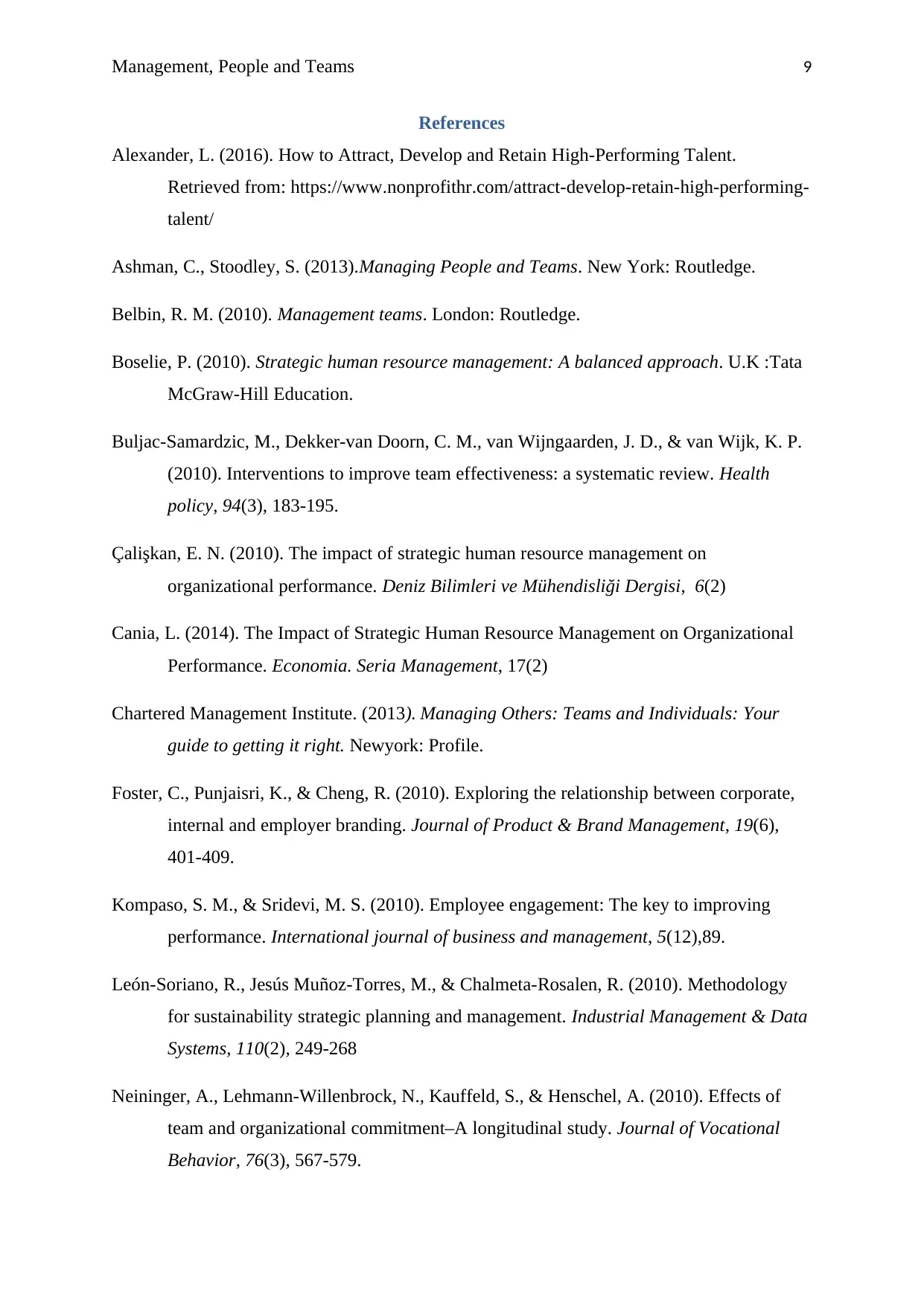
Management, People and Teams 9
References
Alexander, L. (2016). How to Attract, Develop and Retain High-Performing Talent.
Retrieved from: https://www.nonprofithr.com/attract-develop-retain-high-performing-
talent/
Ashman, C., Stoodley, S. (2013).Managing People and Teams. New York: Routledge.
Belbin, R. M. (2010). Management teams. London: Routledge.
Boselie, P. (2010). Strategic human resource management: A balanced approach. U.K :Tata
McGraw-Hill Education.
Buljac-Samardzic, M., Dekker-van Doorn, C. M., van Wijngaarden, J. D., & van Wijk, K. P.
(2010). Interventions to improve team effectiveness: a systematic review. Health
policy, 94(3), 183-195.
Çalişkan, E. N. (2010). The impact of strategic human resource management on
organizational performance. Deniz Bilimleri ve Mühendisliği Dergisi, 6(2)
Cania, L. (2014). The Impact of Strategic Human Resource Management on Organizational
Performance. Economia. Seria Management, 17(2)
Chartered Management Institute. (2013). Managing Others: Teams and Individuals: Your
guide to getting it right. Newyork: Profile.
Foster, C., Punjaisri, K., & Cheng, R. (2010). Exploring the relationship between corporate,
internal and employer branding. Journal of Product & Brand Management, 19(6),
401-409.
Kompaso, S. M., & Sridevi, M. S. (2010). Employee engagement: The key to improving
performance. International journal of business and management, 5(12),89.
León-Soriano, R., Jesús Muñoz-Torres, M., & Chalmeta-Rosalen, R. (2010). Methodology
for sustainability strategic planning and management. Industrial Management & Data
Systems, 110(2), 249-268
Neininger, A., Lehmann-Willenbrock, N., Kauffeld, S., & Henschel, A. (2010). Effects of
team and organizational commitment–A longitudinal study. Journal of Vocational
Behavior, 76(3), 567-579.
References
Alexander, L. (2016). How to Attract, Develop and Retain High-Performing Talent.
Retrieved from: https://www.nonprofithr.com/attract-develop-retain-high-performing-
talent/
Ashman, C., Stoodley, S. (2013).Managing People and Teams. New York: Routledge.
Belbin, R. M. (2010). Management teams. London: Routledge.
Boselie, P. (2010). Strategic human resource management: A balanced approach. U.K :Tata
McGraw-Hill Education.
Buljac-Samardzic, M., Dekker-van Doorn, C. M., van Wijngaarden, J. D., & van Wijk, K. P.
(2010). Interventions to improve team effectiveness: a systematic review. Health
policy, 94(3), 183-195.
Çalişkan, E. N. (2010). The impact of strategic human resource management on
organizational performance. Deniz Bilimleri ve Mühendisliği Dergisi, 6(2)
Cania, L. (2014). The Impact of Strategic Human Resource Management on Organizational
Performance. Economia. Seria Management, 17(2)
Chartered Management Institute. (2013). Managing Others: Teams and Individuals: Your
guide to getting it right. Newyork: Profile.
Foster, C., Punjaisri, K., & Cheng, R. (2010). Exploring the relationship between corporate,
internal and employer branding. Journal of Product & Brand Management, 19(6),
401-409.
Kompaso, S. M., & Sridevi, M. S. (2010). Employee engagement: The key to improving
performance. International journal of business and management, 5(12),89.
León-Soriano, R., Jesús Muñoz-Torres, M., & Chalmeta-Rosalen, R. (2010). Methodology
for sustainability strategic planning and management. Industrial Management & Data
Systems, 110(2), 249-268
Neininger, A., Lehmann-Willenbrock, N., Kauffeld, S., & Henschel, A. (2010). Effects of
team and organizational commitment–A longitudinal study. Journal of Vocational
Behavior, 76(3), 567-579.
Paraphrase This Document
Need a fresh take? Get an instant paraphrase of this document with our AI Paraphraser
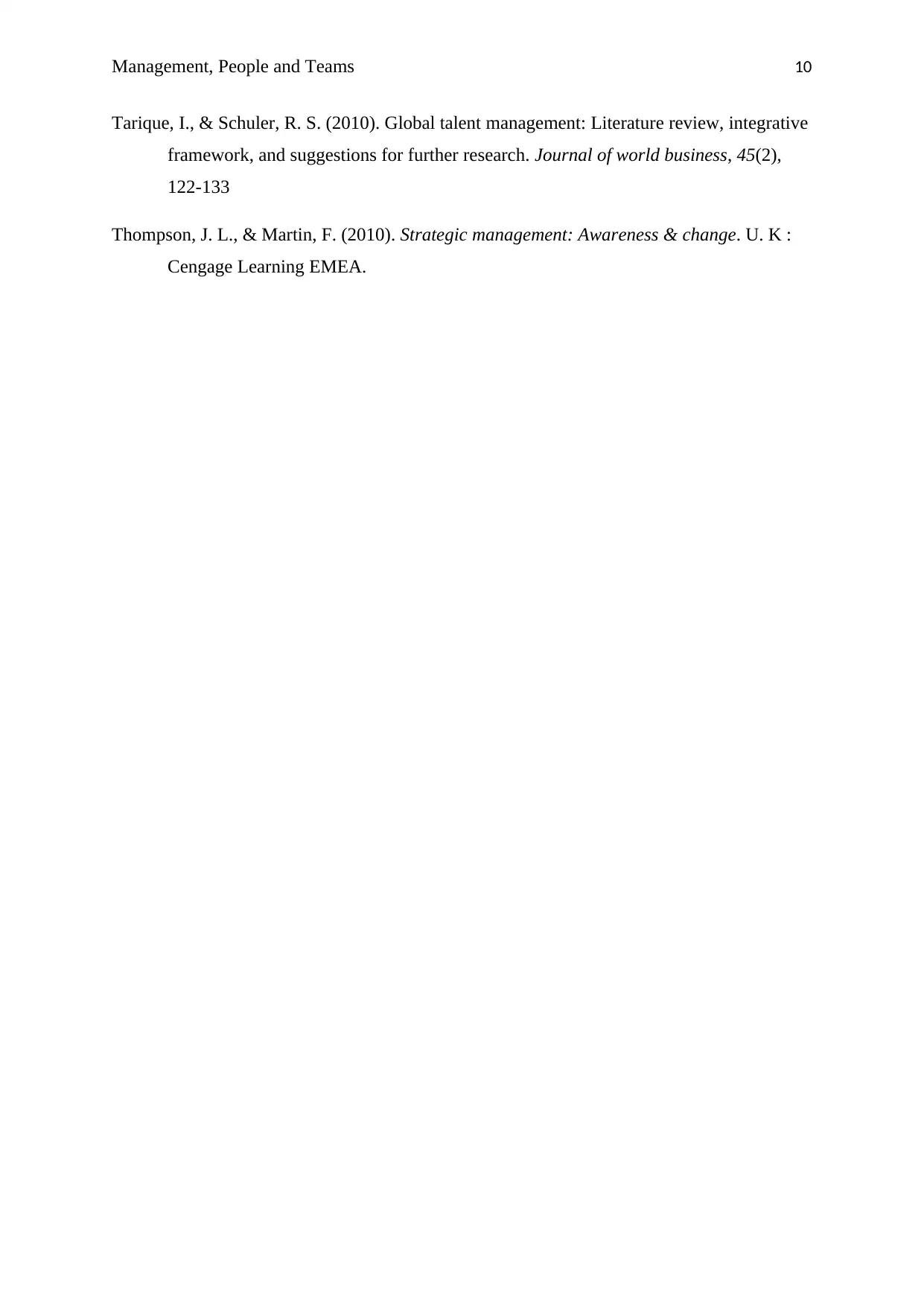
Management, People and Teams 10
Tarique, I., & Schuler, R. S. (2010). Global talent management: Literature review, integrative
framework, and suggestions for further research. Journal of world business, 45(2),
122-133
Thompson, J. L., & Martin, F. (2010). Strategic management: Awareness & change. U. K :
Cengage Learning EMEA.
Tarique, I., & Schuler, R. S. (2010). Global talent management: Literature review, integrative
framework, and suggestions for further research. Journal of world business, 45(2),
122-133
Thompson, J. L., & Martin, F. (2010). Strategic management: Awareness & change. U. K :
Cengage Learning EMEA.
1 out of 11
Related Documents
Your All-in-One AI-Powered Toolkit for Academic Success.
+13062052269
info@desklib.com
Available 24*7 on WhatsApp / Email
![[object Object]](/_next/static/media/star-bottom.7253800d.svg)
Unlock your academic potential
Copyright © 2020–2025 A2Z Services. All Rights Reserved. Developed and managed by ZUCOL.





